The 3rd
LaureateMusic
György Ligeti
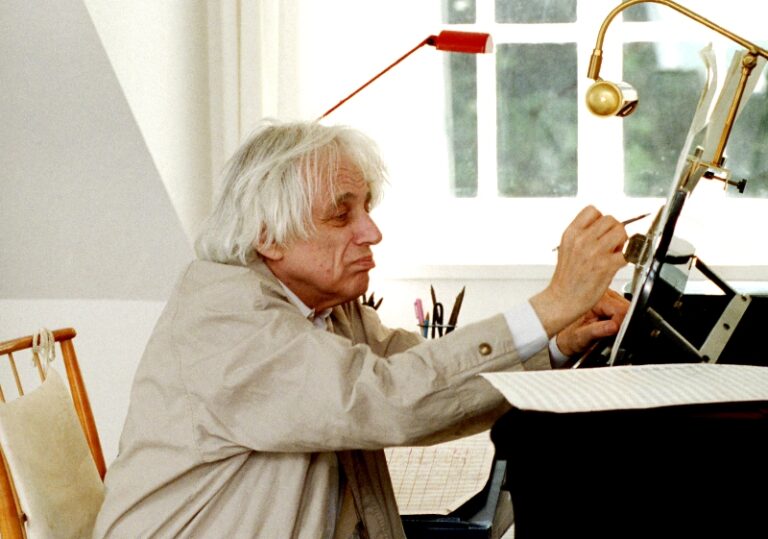
Gyorgy Ligeti’s music is still probably best known to a wide audience because of its (apparently unsanctioned) use in the Stanley Kubrick film 2001: A Space Odyssey. Clocks and clouds,clusters and drift,are the main features of works such as Atmospheres,1961,and Lontano,1965. Many tiny motions combine to create an overall effect of shifting textures. However,Ligeti’s interest in theatre and the absurd is explosive. Amongst his most iconoclastic works is the massive music-theatre piece Le Grande Macabre,1978,which he called an ‘anti-anti-opera’. His influences include non-Western music and non-standard tunings,and he continues to create music of enormous rhythmic complexity,in which the sense of the passage of time is constantly distorted.
Biography
‘I set out to do something new in each piece,but I believe I have always been the same composer,and I think this can be heard in my music.’
In his earliest compositions Ligeti was obliged,for political reasons,to pastiche the prevailing orthodoxies of Hungarian folk-influenced music in the manner of Bartók and Kodaly. Meanwhile,he worked in secret on a number of more adventurous compositions such as the First Quartet,1954. In December 1956 he was at last able to leave Hungary,following the Hungarian uprising in October of that year.
His experiments,after 1957,at the Electronic Studios in Cologne enabled him to set out the basis for his own idiosyncratic compositional method – a method with a number of distinguishing characteristics,each of which he has explored in various ways ever since. The most celebrated and instantly recognisable of these is his use of clusters,close groups of musical pitches. Assigning these clusters to particular groupings of instrumental or vocal timbres,Ligeti created static ‘clouds’ of texture. He then notated tiny motions within the clouds in considerable detail,creating an effect of imperceptible continuous motion,a technique that he termed ‘micropolyphony’. As one group of timbres,say the very top notes on flute and piccolo,drifts off the highest range of the instruments,so a new group enters at the lowest possible level,beginning another gradual drift upwards. This memorable effect is heard most famously in the orchestral pieces Atmosphères,1961,and Lontano,1967,and in the Requiem,1963–65. The inclusion of his music in Stanley Kubrick’s film 2001: A Space Odyssey did a great deal to place this style of music before a wider audience,although Ligeti himself apparently never sanctioned its use.
The slow drift of clusters introduces another crucial concept in Ligeti’s work: the measurement and distortion of music’s passage through time. An early experiment,the Poème Symphonique of 1962,sets 100 metronomes in motion at differing rates. The forest of pulses that results drifts steadily and mechanically into silence. Initially,Ligeti mimicked this process within his cloud compositions,but more recent work has seen him using various mechanical processes to overlay rhythmic and metrical patterns in passages of ferocious complexity. The influence of Conlon Nancarrow’s Studies for Player Piano,which take the multilayering of pulses far beyond the limits of human performance,is felt here,but Ligeti’s continuing series of Etudes for solo piano remain,just about,playable. Even so,a recent performance in London replaced the soloist with a computer,dressed in a bow tie for the occasion; a substitution that met with no opposition from Ligeti.
Ligeti has an explosive interest in the absurd. Among his most iconoclastic works is the massive Le Grand Macabre,1978,which he has called an ‘anti-anti-opera’. This work attacks everything,including the avant-garde convention of attacking genres such as opera. The music is by turns lyrical,complex,comical and parodic. Le Grand Macabre begins with a famous Car-Horn Prelude (in which the cars appear on stage) and is full of wild and freakish behaviour,reflected in the music,which includes two demented high male soprano parts and the pairing of a basso profundo with a dangerously high tenor whose vocal line frequently breaks down into coughs,splutters and hiccups. Quotations and pastiche pepper the score.
In contrast to such absurdism,Ligeti has maintained an interest in non-western musics and microtonalism,in which the octave is divided into smaller parts than the 12 semitones of familiar western music. The use of pitches outside the standard western tuning system is both implied and required in the early cloud pieces,or occurs naturally as a by-product of some of the extended technical devices for which Ligeti calls. In this case,it usually takes the form of inflection or glissando (sliding between notes). However,in later works such as the Horn Trio,1982,Ligeti makes a more controlled use of such tunings,deliberately setting the natural acoustic properties of the horn against the inflexible tuning of the piano. Often such nuances go hand-in-hand with treatments of Latin American or African rhythms,and the homogenous sound-worlds of Indonesian music,although never in an attempt to be merely exotic. Ligeti’s music is full of detail – just as a cloud is composed of millions of individual droplets,so Ligeti’s work contains many tiny musical events which combine to create an overall sound-picture.
Andrew Hugill
Died 12th June,Vienna,2006
Chronology
Aventures (theatre for 3 singers and 7 instrumentalists)
-
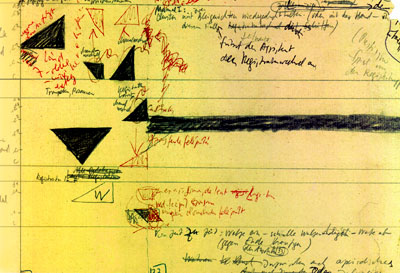
Pages from Ligeti's original sketches of Volumina for organ
-
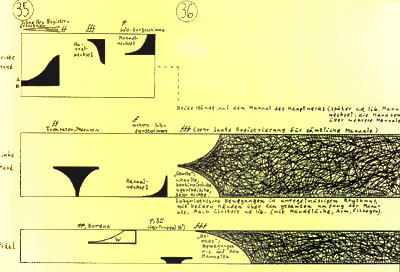
The final printed score of Volumina for organ
-
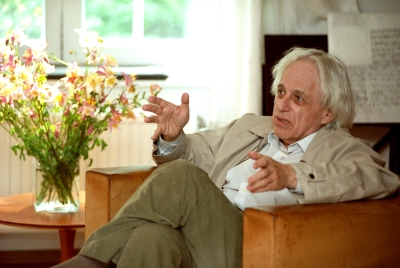
At his home
-
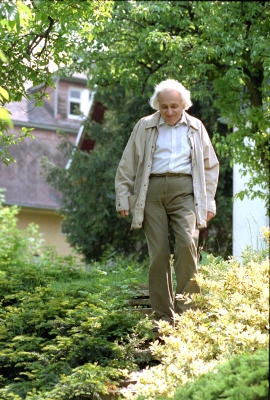
At his home

